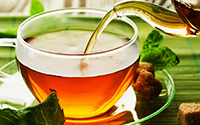Sri Lanka Upcountry Fresh Tea Dust

Sri Lanka (formerly called Ceylon) has a climate and varied elevation that allows for the production of both Camellia sinensis var. assamica and Camellia sinensis var. sinensis, with the assamica varietal holding the majority of production. Tea production is one of the main sources of foreign exchange for Sri Lanka, and accounts for 2% of GDP, contributing over US$1.3 billion in 2021 to the economy of Sri Lanka. It employs, directly or indirectly, over 1 million people, and in 1995 directly employed 215,338 on tea plantations and estates. In addition, tea planting by smallholders is the source of employment for thousands whilst it is also the main form of livelihood for tens of thousands of families. Sri Lanka is the world's fourth-largest producer of tea. In 1995, it was the world's leading exporter of tea (rather than producer), with 23% of the total world export, and Sri Lanka ranked second on tea export earnings in 2020 after China. The highest production of 340 million kg was recorded in 2013, while the production in 2014 was slightly reduced to 338 million kg. India has additionally guaranteed Sri Lanka a shipment of 65,000 metric tons of urea. Sri Lanka's troubled execution of an organic agriculture initiative had pushed the country perilously close to an agricultural crisis. Given the surge in global fertilizer prices, it is improbable that Sri Lanka could procure fertilizer at prevailing market rates. The humidity, cool temperatures, and rainfall of the country's central highlands provide a climate that favors the production of high-quality tea. On the other hand, tea produced in low-elevation areas such as Matara, Galle, and Ratanapura districts with high rainfall and warm temperature has a high level of astringent properties. The tea biomass production itself is higher in low-elevation areas. Such tea is popular in the Middle East. Sri Lanka produces mostly orthodox black teas but also produces CTC, white and green teas. The two types of green tea produced are the gunpowder type and sencha. The industry was introduced to the country in 1867 by James Taylor, a British planter who arrived in 1852. Tea planting under smallholder conditions has become popular in the 1970s. Most of Sri Lanka's export market is in the Middle East and Europe but there are also plenty of bidders worldwide for its specialty high-country-grown Nuwara Eliya teas.
